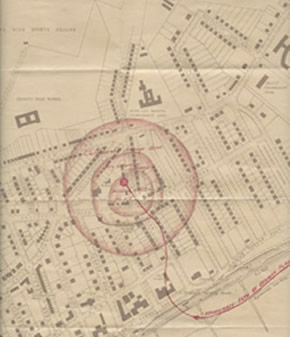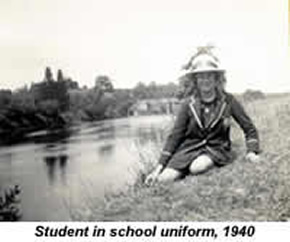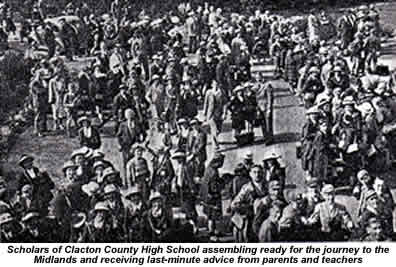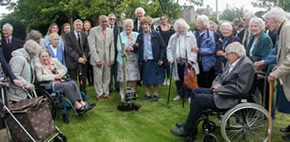The History of CCHS
Featured Story
CCHS by Air
View our fantastic site and facilities from a different perspective......
The Evacuation of CCHS in 1940
 The evactuation of the school followed the crash of a German bomber, carrying sea mines, close to the school in Victoria Road on April, 1940, killing both the crew and the two residents of the house that it hit; these were the first civilian casualties of the war.
The evactuation of the school followed the crash of a German bomber, carrying sea mines, close to the school in Victoria Road on April, 1940, killing both the crew and the two residents of the house that it hit; these were the first civilian casualties of the war.
Footage of the aftermath of the crash was captured by PATHE news.
The pictures show the route of the bomber before it crashed and the devastation caused to the houses, as well as the school.
CCHS 1940 Evacuation 75th Anniversary - 2nd June 2015 - Jump to the full story

The Building of the School
In 1906, a government report decreed that the young seaside resort of Clacton-on-Sea had expanded enough to warrant a Secondary school of its own, allowing children to attend a local school for the first time instead of having to travel to Colchester or Harwich.
However, the developments were delayed because of the onset of World War One. It was not until 1925 that Essex County Council purchased land from Mr Philip Smith of Clay Hall, and a small strip of land from a Mr Griffths (presumably for the entrance to school).

The school was finished in time to be opened for business in September 1928, with prospective pupils having to sit an entrance examination. Other requirements were also needed to attend, including a certificate of good conduct from previous schools and confirmation from parents, agreeing to keep their children at County High for a minimum of four years. They also had to pay for the privilege of attending this school, twelve guineas per year (£12.60), as well as buy all their own books, materials and instruments.

Although the first pupils started in September, Clacton County High School held an official opening ceremony on the 28th November 1928, and it is on this date that the school celebrated its ‘official’ 85th birthday in 2013. In that first September, there were 87 pupils (40 boys and 47 girls) and 4 teachers plus the Headmaster, Mr.Vivian Smith.
The original school was very small compared to today, but for the younger pupils as they arrived on their first day it must have appeared daunting. Originally it was just the front of the school that you see as you approach from the driveway and the ‘East Wing’ (the laboratories that are now in D Block).
 The local paper of the time commented on not only the imposing driveway and front of school, but declared the laboratories to be the finest in the country. The same reporter of 1928 would today no doubt be greeted with howls of protest from staff and pupils alike for his rather smug comment that the laboratories were, ‘guaranteed to delight the heart of any boy’ and the ‘domestic science room would please the heart of any girl’.
The local paper of the time commented on not only the imposing driveway and front of school, but declared the laboratories to be the finest in the country. The same reporter of 1928 would today no doubt be greeted with howls of protest from staff and pupils alike for his rather smug comment that the laboratories were, ‘guaranteed to delight the heart of any boy’ and the ‘domestic science room would please the heart of any girl’.
The pupils spent much longer at school in those days, starting at 9am and working to 4.10pm, although teachers were also allowed to keep pupils up to 5pm if they wished, and ‘organised games’ took place on Saturday mornings.
Detentions were 2 hours long, also carried out on Saturdays, and were considered to be very serious indeed.
 The uniform guidelines were also very strict, even during the war when it was hard to acquire material for clothing.
The uniform guidelines were also very strict, even during the war when it was hard to acquire material for clothing.
The uniform colours were blue and grey, and only black shoes and grey socks were allowed. Outdoor coats had to be all the same, with boys wearing caps, and girls hats. Junior boys wore short trousers, and girls all dressed in a navy blue ‘gymslip’ and white blouses.
On 3rd September 1939 war was declared and this was soon to make a big difference to the school.
London was under threat of being bombed so many of the children of the city were evacuated to safer places around the country, including Clacton.
The Latymer School of Edmonton and their teachers shared the facilities of County High as a result of this evacuation. Lessons and classrooms were shared on a daily basis, with the students from Latymer and County High alternating between morning and afternoon study. Free time was used for games on the field when not in scheduled classroom activities.
 A few months later things took a turn for the worse when the first local civilian casualties of the war occurred at the junction of Victoria Road and Skelmersdale Road, when a German bomber plane crashed on a house (you can see a memorial bench nearby).
A few months later things took a turn for the worse when the first local civilian casualties of the war occurred at the junction of Victoria Road and Skelmersdale Road, when a German bomber plane crashed on a house (you can see a memorial bench nearby).
The Germans invaded Holland, Belgium and France, during which time the noise from the battlefields could be heard in Clacton.
Due to the threat of invasion the East coast of England was declared to be unsafe and a danger for children. On 2nd June 1940 children from this area and their teachers (plus the new additions from London) were again evacuated. Students from Clacton County High were sent to Kidderminster, with the Latymer students going to Tonypandy in Wales. In the meantime the army proceeded to take over the school building.
At the beginning of 1943 Clacton County High reopened for business even though the war was still raging.
One of the last acts of the war in 1945 saw a V2 rocket explode on the sea front, breaking windows in the school. Even though this must have been very scary for staff and students everyone remained safe and things soon got back to normal.
After the war the school began to outgrow the building, as more pupils and staff arrived.
A ‘West Wing’ was added in 1946 to accommodate this increase, with more extensions following in 1958 and 1963. The 1970’s saw a whole new block materialise, which is now known as F and G block. Up until recent school improvement work was completed in 2004, the different sides of the school were referred to as the ‘old block’ and the ‘new block’, even though the new block was over 30 years old!
The original headmaster, Mr Smith stayed until he retired in 1958. He had been at the school for 30 years, however he has not been the longest serving member of staff; that honour goes to his secretary Miss Hilda Freeman who stayed working for the school until her retirement in 1975 after serving for a remarkable 45 years.

Clacton County High has only ever had six Head teachers. The original Mr Smith, was replaced by Dr Gardner who sadly died after only 2 terms in office.
Another Mr Smith took charge for 25 years before handing over to Mr Clay who took charge for a further 23 years. Mr Brindle followed in 2007 before handing the reins to then Vice-Principal, Mr Gallagher to become Executive Principal of the school in 2015. Mr Brindle left CCHS to become CEO of the newly formed Sigma Academy Trust in September 2016, of which CCHS is the lead school. We have grown from 87 pupils and 4 teachers to over 1700 pupils taught by 116 teachers, and from a single school secretary to 106 administrative and support staff.

Images of yesteryear



During the 1958 – 1959 season the football team was very successful, having played 14, won 10, drawn 3 and only losing 1. A fitting climax to the season also saw the first XI retaining the Hicks Cup, beating Palmers School with a thrilling 5 – 4 victory.
An extract from the 1959 Clactonian, written by the team captain Andrew Evans, describes these achievements:
‘This success may be attributed to two main factors: throughout the season the team endeavoured to play a high standard of football and, secondly, equal importance was attached to physical fitness and stamina, and it is significant that on numerous occasions victory was gained by the scoring of goals in the last quarter of an hour against tiring opponents.’
Particular praise was given to J.F. McCurdy (seen below), who was described as giving the team, ‘true strength’ in his half-back position.
Clacton County High School has always been very successful in both academic and sporting achievements.
We have also been renowned for Performing Arts throughout the school’s eighty years; this is evident in our obtaining our current specialist Arts College Status in 1998.
 The school musical has long been a highlight of the school year and it was no different in 1978 when the production was 'Oliver!'
The school musical has long been a highlight of the school year and it was no different in 1978 when the production was 'Oliver!'
A review by two of the actors, Jeremy Moodey (Fagin)and Richard Moodey (Mr Bumble) gives a vivid description of the production:
The school stage was still shaking from the aftermath of "School and Crossbones'' at Christmas 1976, and there were still traces of makeup behind the cast’s ears when Mr Ken Smith a started to tout for support for a production of Lionel Bart’s “Oliver!” in the spring of 1978 - the School Jubilee year. With Mr Smith directing and producing and Mr Hurren as musical director, it promised to be an enjoyable production and a large number turned up at the initial meeting in the New Year. Auditions were in full swing by spring and by the summer holidays most parts had been filled. Nothing else was heard until late Autumn 1977 whenscripts were distributed and rehearsals commenced. The only major part not to be filled by then was Bill Sykes and after appeals by Mr Smith, Grant Widlake bravely stepped forward. We entered the New Year and the show seemed alarmingly close. January.... February ... March. The big month. By mid-March we were already to face the masses and our first performance was a matinee-cum-dress rehearsal in front of 300 primary school children. Though this was a golden opportunity to skip lessons, the cast regarded the matinee with caution, picturing long queues of little children streaming out to the lavatory in mid-performance. Our fears were ill-founded and two good matinee performances gave us hope for the first night. It came and passed relatively hltchless with our more cultivated audience showing much more appreciation than the juniors. We faced the second night with even greater expectations. DISASTER! People forget their lines, entries were squandered, scenery dropped and notes missed - the night seemed a dismal failure. To our great surprise we got even more applause than the previous night. Our flagging spirits were bolstered and we faced the last night knowing that, failure or not, we would still have an after show party. In the end the performance was great success and as soon as we were out of costume and make-up we were into our party gear and bombing off to the sixth-form suite for the disco. This too was a great success with our demented stage crew crashing around the room to such varied sounds as “Zorbas Dance” and “Holiday in the Sun”. As a token of the cast's appreciation Mr Smith and Mr Hurren received a half bottle of whisky each while the costumiers, Mrs Redfern an Mrs Sorrenti got a box of chocolates each. Everyone went away happy and wondering: What next year?
The last word goes to Miss Hilda Freeman, that longest serving member of staff, who wrote a short paragraph that was published as part of a celebration of the school’s Golden Jubilee in 1978.
‘… I remember with affection the 45 years I spent in such a fine school. We have had our ‘downs’ naturally, but the ‘ups’ more than compensate, and all past and present members of the school, in their several capacities, should feel nothing but pride in having had the privilege to be part of THE County High School…’
Compiled by Marina Lee, Librarian, Clacton County High School. November 2008
CCHS Evacuation 75th Anniversary - 2nd June 2015
 Over twenty former CCHS students, most in their late 80’s or early 90’s, returned to school on the 2nd June for the 75th Anniversary of their wartime evacuation. On Sunday 2nd June, 75 years ago over three hundred CCHS students arrived at school dressed in their uniform with one small suitcase packed with their essentials and their obligatory gas mask. Parents were not allowed to enter the school grounds, to watch the whole school march to the railway station or wave them off as they departed by train to an unknown destination, along with hundreds of other Junior School children. It was more than two weeks until their parents knew where they had gone or of their well-being. Imagine today not knowing where or how your child was for that length of time – how different it is 75 years on!
Over twenty former CCHS students, most in their late 80’s or early 90’s, returned to school on the 2nd June for the 75th Anniversary of their wartime evacuation. On Sunday 2nd June, 75 years ago over three hundred CCHS students arrived at school dressed in their uniform with one small suitcase packed with their essentials and their obligatory gas mask. Parents were not allowed to enter the school grounds, to watch the whole school march to the railway station or wave them off as they departed by train to an unknown destination, along with hundreds of other Junior School children. It was more than two weeks until their parents knew where they had gone or of their well-being. Imagine today not knowing where or how your child was for that length of time – how different it is 75 years on!
 The CCHS Evacuees, all with their ‘wartime name tags’ around their necks, enjoyed an afternoon reception at school where they received a memento anniversary booklet, containing a copy of their original CCHS report card; this was certainly a talking point and caused some hilarity. Year 7 students had prepared a light tea of sandwiches and cakes whilst students from a range of year groups, listened intently to the stories that the evacuees told of the day and their time away from Clacton.
The CCHS Evacuees, all with their ‘wartime name tags’ around their necks, enjoyed an afternoon reception at school where they received a memento anniversary booklet, containing a copy of their original CCHS report card; this was certainly a talking point and caused some hilarity. Year 7 students had prepared a light tea of sandwiches and cakes whilst students from a range of year groups, listened intently to the stories that the evacuees told of the day and their time away from Clacton.
Our guests also enjoyed looking at presentations by current students, who had written poems based on film footage that they had watched of the evacuation day, which was also shown during the reception, and at a display of artwork. There were also whole school photos from 1937 and 1947 that spanned the time that our guests were students at CCHS and copies of the original school plans. Many also returned to their old classrooms to see how they and the school had changed since their time here. The whole event was covered by BBC Look East, whose cameraman was related to a number of the former CCHS evacuees who attended the reunion.
Some of the Evacuation film footage from 1940. Courtesy of the University of East Anglia - East Anglian Film Archive
